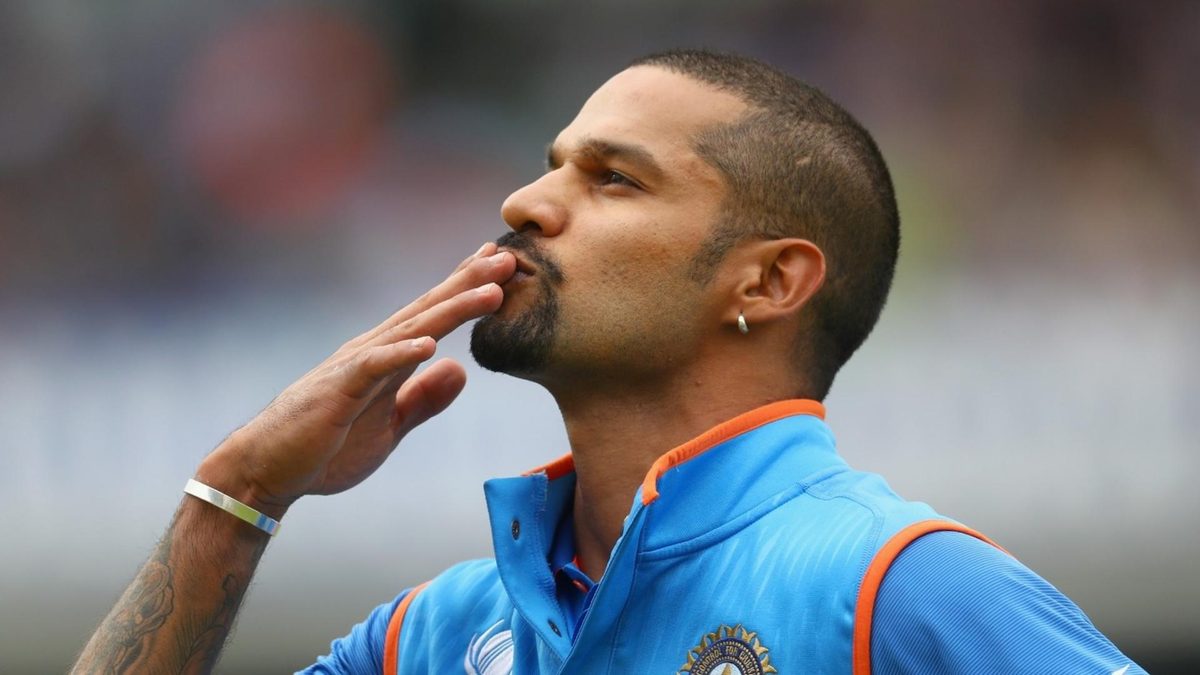
has retired – without much fanfare or drama – bringing an end to a memorable career. Aadya Sharma writes on the legacy he leaves behind.
There will come a time when the younger lot will ask you what the fuss around Shikhar Dhawan was all about.
Didn’t he play like 30 odd Tests?
Yeah, about thirty-four across five years.
Okay, was he a T20I player? His strike rate is just over 125.
Well, yeah… I mean, no. Not quite.
It didn’t quite happen, but Dhawan had the game to excel in either format. When in whites, his defence was clean, the technique neat, but he refused to go into a shell, backing his drives and cuts to keep going. The drives were, in fact, gorgeous, punishing anything that was offered too full. Fully-committed to it, leaning in.
Nothing half-hearted, just like his mantra for life.
If you weren’t around, you won’t quite understand the influence of his debut sizzle. India were just about preparing for life after Virender Sehwag. For a good ten years, the average India fan was conditioned to seeing Test openers bat a certain way.
And then came the 27-year-old debutant, armed with a borrowed bat, promising a lot more of the blood-kicking stuff. Unfortunately, the impactful moments were far and few.
View this post on Instagram
In T20Is, Dhawan was more mellow than his game suggested. There was a punch, but his power felt restrained, often building towards something before losing steam. The powerplay was never his hunting ground, a misfitting attribute in new-age T20 cricket.
What was it about him then?
Undoubtedly, the one-day format was the variety of his choice, and the numbers push him towards the territory of greats. It was the format that best defines his cricketing legacy. If you are not convinced, read this.
On an aesthetic level, Dhawan’s game offered ease, a languid exhibition of steady, well-paced excitement. It was oxymoronic in a way, like power yoga. It was fast, but not burn-out fast.
The off-side, just like so many great southpaws, was his sparkling comfort zone. The leg-side play was adequately stocked, but less concerning. One of his shots was a walking flick, as if he was advancing and falling over, but he never needed too much power to beat the ball to the fence.
When he wanted to, he could pull out a wild swipe to cow-corner. The bat would twist in his hand, but it would still have enough to carry through.
That was Dhawan: comfortable in his strengths, and comfortable in his inadequacies.
The true measure of Dhawan’s brilliance will always remain his excellent record in multi-team events. He was a big-match performer, bankable to a fault when it mattered. Along with Virat Kohli and Rohit Sharma, Dhawan formed a triumvirate of white-ball superheroes. The other two had bigger fanbases, but Dhawan had the least haters.
As a nation festered on their duopoly, Dhawan was comfortable as the supporting act. He was never the biggest draw, and he never tried to overreach. But you knew he was around, and he’ll do good. And he did good.
Yet, as the 2010s progressed and concluded, the other two formats tugged at Dhawan’s success. ODI cricket became the in-between format. Suddenly, India did not know what to do with Dhawan. An explosion of T20 talent threatened to wipe him away. Rohit and Kohli survived, but Dhawan was left behind.
Post-Covid, Dhawan became a senior with few powers. It can be said that he never really bothered to adapt, caught up by the youngsters he captained on B-tours. Some were frustrated to see his post-dismissal grins, wondering if he was still serious enough to try harder.
But Dhawan actually adapted, improving his attacking intent in T20s. By 2020, he was able to turn his batting impact from negative to positive in the IPL, but by then, India had begun moving on from him.
Yet, if there was any frustration of not turning good into great, Dhawan did not bare it. His personal life and cricketing trajectory twisted into complicated knots, but Dhawan took it all in with a beaming smile.
“I don’t put unnecessary pressure on myself. It’s a race that never ends,” Dhawan said two years ago. “If I get into that mindset, I will not be happy and it’s not good energy.”
There was no jealousy, no potshots, no social-media stabbing. Heck, he picked the in-form Shubman Gill over himself when asked who’d he rather in India’s World Cup squad. Hardly has he been troubled by verbal bouts on the pitch, and rarely has he given anything back.
- 34 Tests, 167 ODIs, 68 T20Is,
— Wisden India (@WisdenIndia) August 27, 2024
- 10,867 international runs
- 24 centuries
- 6,679 IPL runs
What's your favourite memory from Shikhar Dhawan's brilliant career? ✨ pic.twitter.com/Wtalhghzz1
For a man nicknamed after Bollywood’s most popular antagonist, Gabbar’s softer side really made him a crowd favourite, cutting all the fluffy aura around India’s cricketing demigods. He played the flute and danced in outlandish skits, smiling all the way. Your heart tugged when he revealed he hadn’t spoken to his much-adored son in months, even as he stayed away from publicising the painful ripples of a toxic divorce.
Dhawan’s absence isn’t sudden, we’ve seen him slowly walk into the sunset. But on the way out, he did teach a thing and a half about being content with oneself around life’s weird ways.
“I criticise myself and appreciate myself. I am my best friend,” Dhawan had once said. “I love cricket, but I have learnt that one can be in love and still be detached.”
Lovely personality, solid cricketer… that’s what the fuss around Dhawan was all about.
Follow Wisden for all cricket updates, including live scores, match stats, quizzes and more. Stay up to date with the latest cricket news, player updates, team standings, match highlights, video analysis and live match odds.








